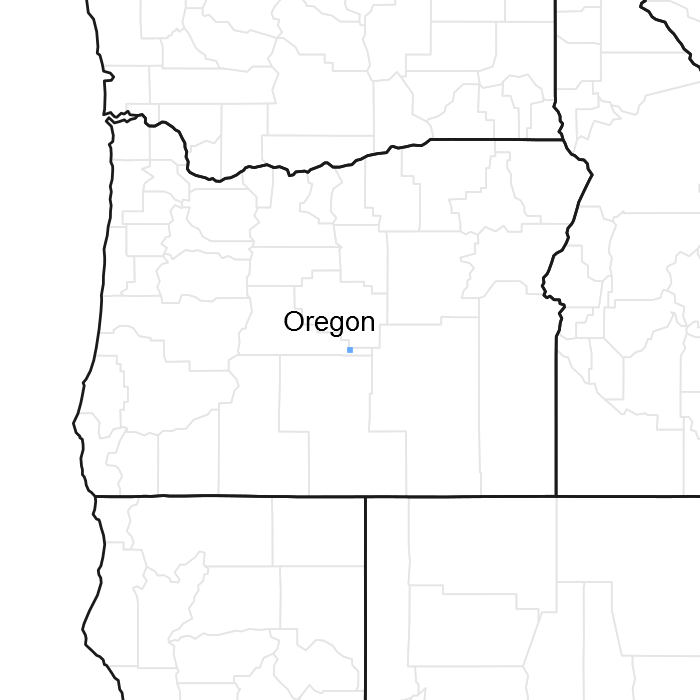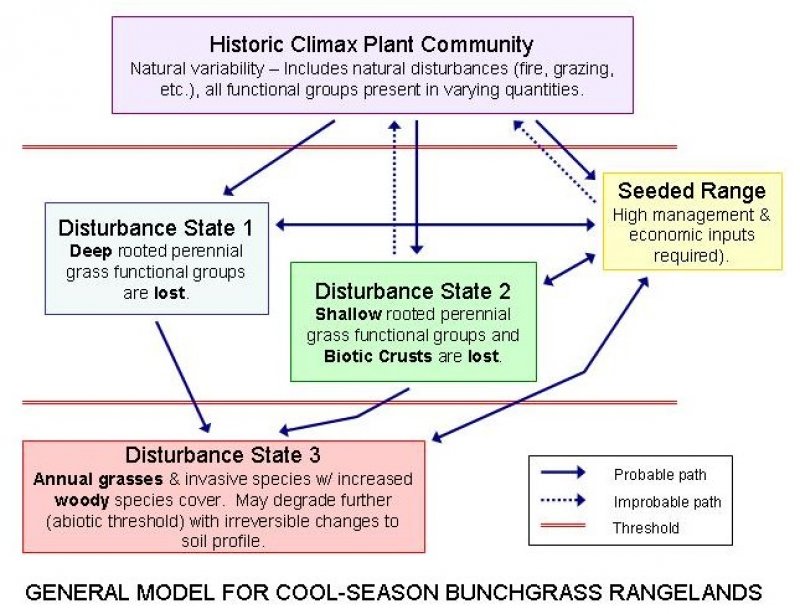
Natural Resources
Conservation Service
Ecological site R023XY219OR
SHALLOW ASHY 10-12 PZ
Accessed: 12/21/2025
General information
Provisional. A provisional ecological site description has undergone quality control and quality assurance review. It contains a working state and transition model and enough information to identify the ecological site.

Figure 1. Mapped extent
Areas shown in blue indicate the maximum mapped extent of this ecological site. Other ecological sites likely occur within the highlighted areas. It is also possible for this ecological site to occur outside of highlighted areas if detailed soil survey has not been completed or recently updated.
Associated sites
| R023XY202OR |
SWALE 10-14 PZ Swale 10-14" PZ |
|---|
Similar sites
| R023XY515OR |
DROUGHTY PUMICE 9-12 PZ Droughty Ashy 9-12" PZ |
|---|
Table 1. Dominant plant species
| Tree |
Not specified |
|---|---|
| Shrub |
Not specified |
| Herbaceous |
Not specified |
Physiographic features
This site occurs on gentle plateau slopes, rolling hills, and the floor of basins, primarily on the eastern edge of the pumice zone in the High Desert. Slopes range from 1 to 10 percent. Elevations range from 4300 to 5200 feet.
Table 2. Representative physiographic features
| Landforms |
(1)
Hill
(2) Basin floor (3) Plateau |
|---|---|
| Elevation | 4,300 – 5,200 ft |
| Slope | 1 – 10% |
| Aspect | Aspect is not a significant factor |
Climatic features
The annual precipitation ranges from 9 to 11 inches, which occurs mainly between the months of November and June, mostly in the form of snow and spring-fall rains. The soil temperature regime is frigid. The average annual air temperature is 44 degrees F with extreme temperatures ranging from -25 to 104 degrees F. The frost-free period is 50 to 90 days. The optimum period for plant growth is from April through early July.
Table 3. Representative climatic features
| Frost-free period (average) | 90 days |
|---|---|
| Freeze-free period (average) | 0 days |
| Precipitation total (average) | 11 in |
Influencing water features
Soil features
The soils of this site are shallow and well-drained. They have a sandy loam surface texture, and medium textured subsoils. They are generally formed from volcanic ash and the underlying bedrock. Permeability is moderately slow and the available water holding capacity (AWC) is 2 to 3 inches for the profile. The potential for wind erosion is high.
Table 4. Representative soil features
| Surface texture |
(1) Sandy loam |
|---|---|
| Drainage class | Somewhat poorly drained to well drained |
| Permeability class | Moderately slow |
| Available water capacity (0-40in) |
2 – 3 in |
Ecological dynamics
Range in Characteristics:
Areas with less pumice or greater stone and gravel content have less Idaho fescue and more bluebunch wheatgrass.
Response to Disturbance and Invader Species:
Fire reduces the proportion of sagebrush and increases rabbitbrush. Overgrazing encourages sagebrush and rabbitbrush after a decline in bluebunch wheatgrass and Idaho fescue.
State and transition model

More interactive model formats are also available.
View Interactive Models
More interactive model formats are also available.
View Interactive Models
Click on state and transition labels to scroll to the respective text
Ecosystem states
State 1 submodel, plant communities
State 1
Historic Climax Plant Community
Community 1.1
Historic Climax Plant Community
The potential native plant community is dominated by Wyoming big sagebrush. Bluebunch wheatgrass and Idaho fescue are co-dominant grasses. Sandberg bluegrass and Thurber needlegrass are common along with a wide variety of forbs.
Figure 2. Annual production by plant type (representative values) or group (midpoint values)
Table 5. Annual production by plant type
| Plant type | Low (lb/acre) |
Representative value (lb/acre) |
High (lb/acre) |
|---|---|---|---|
| Grass/Grasslike | 504 | 628 | 752 |
| Shrub/Vine | 48 | 92 | 136 |
| Forb | 8 | 44 | 80 |
| Total | 560 | 764 | 968 |
Additional community tables
Table 6. Community 1.1 plant community composition
| Group | Common name | Symbol | Scientific name | Annual production (lb/acre) | Foliar cover (%) | |
|---|---|---|---|---|---|---|
|
Grass/Grasslike
|
||||||
| 1 | Perennial, deep-rooted, dominant | 440–600 | ||||
| bluebunch wheatgrass | PSSP6 | Pseudoroegneria spicata | 240–320 | – | ||
| Idaho fescue | FEID | Festuca idahoensis | 200–280 | – | ||
| 2 | Perennial, deep-rooted, sub-dominant | 16–40 | ||||
| Thurber's needlegrass | ACTH7 | Achnatherum thurberianum | 16–40 | – | ||
| 4 | Perennial, shallow-rooted, sub-dominant | 40–80 | ||||
| Sandberg bluegrass | POSE | Poa secunda | 40–80 | – | ||
| 5 | Other perennial grasses, all | 8–32 | ||||
| Indian ricegrass | ACHY | Achnatherum hymenoides | 0–8 | – | ||
| squirreltail | ELEL5 | Elymus elymoides | 0–8 | – | ||
| prairie Junegrass | KOMA | Koeleria macrantha | 0–8 | – | ||
| Cusick's bluegrass | POCU3 | Poa cusickii | 0–8 | – | ||
|
Forb
|
||||||
| 9 | Other perennial forbs, all | 8–80 | ||||
| onion | ALLIU | Allium | 0–5 | – | ||
| pussytoes | ANTEN | Antennaria | 0–5 | – | ||
| curvepod milkvetch | ASCU4 | Astragalus curvicarpus | 0–5 | – | ||
| basalt milkvetch | ASFI | Astragalus filipes | 0–5 | – | ||
| freckled milkvetch | ASLE8 | Astragalus lentiginosus | 0–5 | – | ||
| mariposa lily | CALOC | Calochortus | 0–5 | – | ||
| tapertip hawksbeard | CRAC2 | Crepis acuminata | 0–5 | – | ||
| buckwheat | ERIOG | Eriogonum | 0–5 | – | ||
| desert yellow fleabane | ERLI | Erigeron linearis | 0–5 | – | ||
| purple cushion fleabane | ERPO2 | Erigeron poliospermus | 0–5 | – | ||
| bigseed biscuitroot | LOMA3 | Lomatium macrocarpum | 0–5 | – | ||
| shortstem lupine | LUBR2 | Lupinus brevicaulis | 0–5 | – | ||
| beardtongue | PENST | Penstemon | 0–5 | – | ||
| tufted phlox | PHCA7 | Phlox caespitosa | 0–5 | – | ||
| largehead clover | TRMA3 | Trifolium macrocephalum | 0–5 | – | ||
| foothill deathcamas | ZIPA2 | Zigadenus paniculatus | 0–5 | – | ||
|
Shrub/Vine
|
||||||
| 11 | Perennial, all, dominant | 40–120 | ||||
| Wyoming big sagebrush | ARTRW8 | Artemisia tridentata ssp. wyomingensis | 40–120 | – | ||
| 15 | Other perennial shrubs, all | 8–16 | ||||
| yellow rabbitbrush | CHVI8 | Chrysothamnus viscidiflorus | 8–16 | – | ||
Interpretations
Animal community
Livestock Grazing:
Water is usually not available on this site. Winter grazing is possible in mild winters without heavy snow.
Native Wildlife Associated with the Potential Climax Community:
Pronghorn antelope
Mule deer
Pronghorn antelope use this site as winter range.
Hydrological functions
The soils of this site have high infiltration rates and low runoff potential.
Other information
Adapted species for seeding include crested wheatgrass, Siberian wheatgrass, tall wheatgrass, sheep fescue, bluebunch wheatgrass, and beardless wheatgrass. Due to shallow soils, this site has low potential for seeding.
Supporting information
Contributors
Gene Hickman
J P Repp
M. Parks (OSU)
Rangeland health reference sheet
Interpreting Indicators of Rangeland Health is a qualitative assessment protocol used to determine ecosystem condition based on benchmark characteristics described in the Reference Sheet. A suite of 17 (or more) indicators are typically considered in an assessment. The ecological site(s) representative of an assessment location must be known prior to applying the protocol and must be verified based on soils and climate. Current plant community cannot be used to identify the ecological site.
| Author(s)/participant(s) | Jeff Repp |
|---|---|
| Contact for lead author | Oregon NRCS State Rangeland Management Specialist |
| Date | 08/16/2012 |
| Approved by | Bob Gillaspy |
| Approval date | |
| Composition (Indicators 10 and 12) based on | Annual Production |
Indicators
-
Number and extent of rills:
None -
Presence of water flow patterns:
None -
Number and height of erosional pedestals or terracettes:
None -
Bare ground from Ecological Site Description or other studies (rock, litter, lichen, moss, plant canopy are not bare ground):
10-25% -
Number of gullies and erosion associated with gullies:
None -
Extent of wind scoured, blowouts and/or depositional areas:
None to some, Severe wind erosion hazard -
Amount of litter movement (describe size and distance expected to travel):
Fine - limited movement -
Soil surface (top few mm) resistance to erosion (stability values are averages - most sites will show a range of values):
Slight resistant to erosion: aggregate stability = 1-2 -
Soil surface structure and SOM content (include type of structure and A-horizon color and thickness):
Shallow well drained sandy loams: Low OM (1-2%) -
Effect of community phase composition (relative proportion of different functional groups) and spatial distribution on infiltration and runoff:
Moderate ground cover (60%) and gentle slopes (1-10%) moderately limit rainfall impact and overland flow -
Presence and thickness of compaction layer (usually none; describe soil profile features which may be mistaken for compaction on this site):
None -
Functional/Structural Groups (list in order of descending dominance by above-ground annual-production or live foliar cover using symbols: >>, >, = to indicate much greater than, greater than, and equal to):
Dominant:
Bluebunch wheatgrass > Idaho fescue > other grasses > shrubs > forbsSub-dominant:
Other:
Additional:
-
Amount of plant mortality and decadence (include which functional groups are expected to show mortality or decadence):
Normal decadence and mortality expected -
Average percent litter cover (%) and depth ( in):
-
Expected annual annual-production (this is TOTAL above-ground annual-production, not just forage annual-production):
Favorable: 1000, Normal: 800, Unfavorable: 600 lbs/acre/year at high RSI (HCPC) -
Potential invasive (including noxious) species (native and non-native). List species which BOTH characterize degraded states and have the potential to become a dominant or co-dominant species on the ecological site if their future establishment and growth is not actively controlled by management interventions. Species that become dominant for only one to several years (e.g., short-term response to drought or wildfire) are not invasive plants. Note that unlike other indicators, we are describing what is NOT expected in the reference state for the ecological site:
Perennial brush species will increase with deterioration of plant community. Cheatgrass invades sites that have lost deep rooted perennial grass functional groups. -
Perennial plant reproductive capability:
All species should be capable of reproducing annually
Print Options
Sections
Font
Other
The Ecosystem Dynamics Interpretive Tool is an information system framework developed by the USDA-ARS Jornada Experimental Range, USDA Natural Resources Conservation Service, and New Mexico State University.
Click on box and path labels to scroll to the respective text.